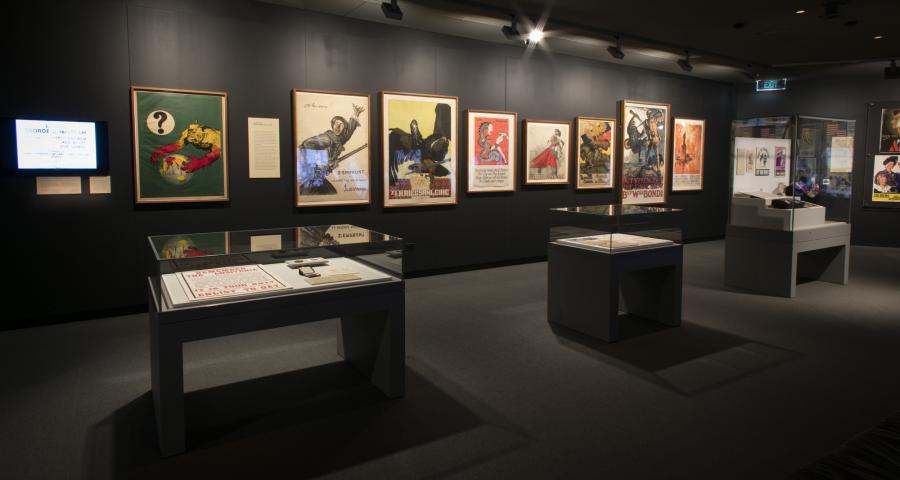'The Thing We Fight'

Artist Norman Lindsay's 1918 propaganda poster featuring the German "Hun".
With a face twisted into an evil grimace and blood-soaked hands dripping over Europe, the ape-like German ogre clutches at the globe as it threatens to take over the world.
It’s a striking image, and Norman Lindsay’s bloody portrayal of the German Hun during the First World War is now on display at the Australian War Memorial as part of the Hearts and minds: wartime propaganda exhibition.
According to curator Alex Torrens, Lindsay’s controversial work is one of the most iconic Australian First World War posters.
“I couldn’t go past the Lindsay,” Torrens said. “It was one of a series of six designs that Lindsay produced towards the end of the war for the Australian government’s final nation-wide recruitment campaign, and it’s notable for being such a vicious example of the demonisation of the enemy.
“It copped quite a bit of criticism when it came out. It was surreptitiously put up one night without really telling anyone … and it attracted a lot of adverse reaction and, of course, the war ended before the campaign could be unleashed in full.”
The poster was to be followed at intervals of seven to ten days by Lindsay’s other works – Be quick, God bless daddy, Will you fight?, The last call and Fall in. At the same time, a mailing notice was sent to each eligible man and the German monster appeared in a leaflet above the caption “The Thing We Fight”. However, the armistice was signed before the last two posters were issued.
“It was part of a very orchestrated and well-designed campaign,” Torrens said.
“It featured in a recruitment kit that included mail out letters to eligible men which were sent directly to their houses and was also made into a cartoon by Harry Julius and shown in cinemas.
“The cartoon is also on display, providing a rare opportunity for visitors to see both the poster and the animation side-by-side in the gallery.”
Lindsay’s German ogre is one of the rare examples of Australian poster art produced in war without a letterpress. It is considered an excellent example of the crude caricature and vilification of the enemy and is in keeping with Lindsay's portrayal of “the Hun” in his many cartoons produced for the Sydney Bulletin during the First World War.
At the time of its unveiling, the poster provoked protests in parliament, and the Minister for Recruiting, R. B. Orchard, considered withdrawing it in October 1918. Today the artwork is part of the national collection, taking pride of place among the First World War posters in the Hearts and minds: wartime propaganda exhibition.
“The Memorial’s collection of wartime propaganda posters is one of the hidden treasures in the national collection,” Torrens said.
“Only about 20 per cent of the poster collection is accessible on the website so I really relished this opportunity to open up cabinets and bring them out.
“I wanted to focus on the strengths of the poster collection, which is the First and Second World War holdings, and enhance them by displaying them with the most engaging objects and personal stories that I could find.”
Hearts and Minds focuses on home-front propaganda from the First and Second World Wars and features some of the world’s most iconic propaganda posters, including Uncle Sam, Lord Kitchener, and one of the original British “Keep calm and carry on” posters. It also features works by American writer and illustrator Dr Seuss and British cartoonist Cyril “Fougasse” Bird, as well as film and animation, a pin cushion featuring a caricature of Adolf Hitler, and a Walt Disney jigsaw puzzle.
“The exhibition is an opportunity for people to reflect and think about the power of visual communication and how these images resonate differently across decades and across time,” Torrens said. “[And] I’m hoping they will do what posters do, which is engage people as they are walking through.”
Hearts and Minds: Wartime Propaganda is on display on the mezzanine level in Anzac Hall at the Australian War Memorial.
Curator Alex Torrens will present free gallery talks at the Memorial at 11.30am on 1 March 2018 and 5 April 2018.
